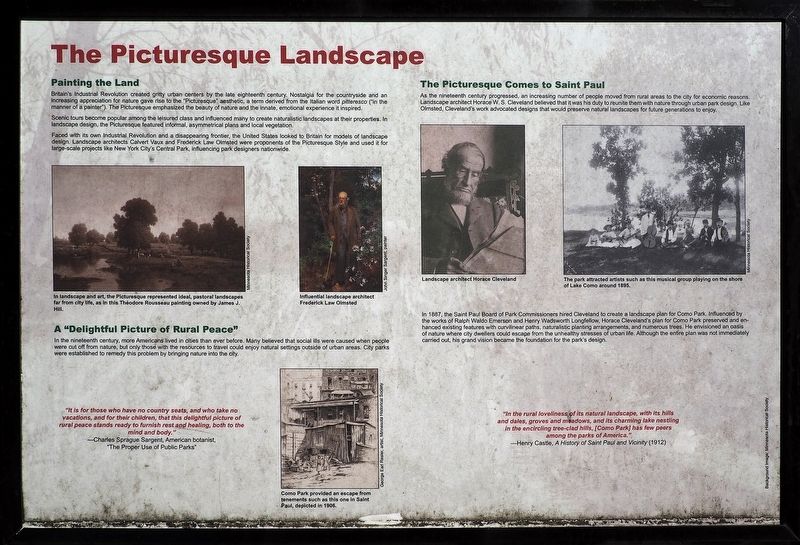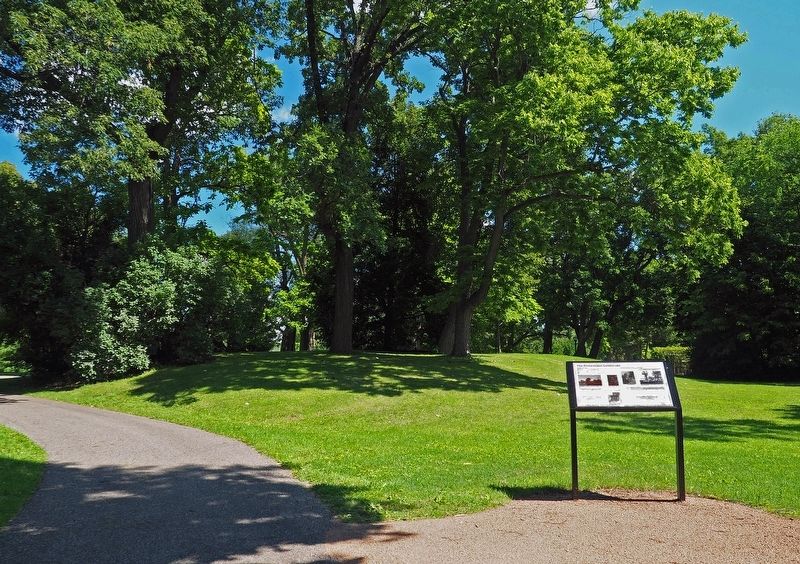Como Park in Saint Paul in Ramsey County, Minnesota — The American Midwest (Upper Plains)
The Picturesque Landscape
Painting the Land
Britain's Industrial Revolution created gritty urban centers by the late eighteenth century. Nostalgia for the countryside and an increasing appreciation for nature gave rise to the "Picturesque" aesthetic, a term derived from the Italian word pitteresco ("in the manner of a painter"). The Picturesque emphasized the beauty of nature and the innate, emotional experience it inspired.
Scenic tours became popular among the leisured class and influenced many to create naturalistic landscapes at their properties. In landscape design, the Picturesque featured informal, asymmetrical plans and local vegetation.
Faced with its own Industrial Revolution and a disappearing frontier, the United States looked to Britain for models of landscape design. Landscape architects Calvert Vaux and Frederick Law Olmsted were proponents of the Picturesque Style and used it for large-scale projects like New York City's Central Park, influencing park designers nationwide.
A "Delightful Picture of Rural Peace"
In the nineteenth century, more Americans lived in cities than ever before. Many believed that social ills were caused when people were cut off from nature, but only those with the resources to travel could enjoy natural settings outside of urban areas. City parks were established to remedy this problem by bringing nature into the city.
The Picturesque Comes to Saint Paul
As the nineteenth century progressed, an increasing number of people moved from rural areas to the city for economic reasons. Landscape architect Horace W. S. Cleveland believed that it was his duty to reunite them with nature through urban park design. Like Olmsted, Cleveland's work advocated designs that would preserve natural landscapes for future generations to enjoy.
In 1887, the Saint Paul Board of Park Commissioners hired Cleveland to create a landscape plan for Como Park. Influenced by the works of Ralph Waldo Emerson and Henry Wadsworth Longfellow, Horace Cleveland's plan for Como Park preserved and enhanced existing features with curvilinear paths, naturalistic planting arrangements, and numerous trees. He envisioned an oasis of nature where city dwellers could escape from the unhealthy stresses of urban life. Although the entire plan was not immediately carried out, his grand vision became the foundation for the park's design.
Caption:
In landscape and art, the Picturesque represented ideal, pastoral landscapes far from city life, as in this Théodore Rousseau painting owned by James J. Hill. Quote: "It is for those who have no country seats, and who take no vacations, and for their children, that this delightful picture of rural peace stands ready to furnish rest and healing, both to the mind and body." —Charles Sprague Sargent, American botanist, "The Proper Use of Public Parks"
Caption:
Como Park provided an escape from tenements such as this one in Saint Paul, depicted in 1906.
Caption:
The park attracted artists such as this musical group playing on the shore of Lake Como around 1895. Quote: "In the rural loveliness of its natural landscape, with its hills and dales, groves and meadows, and its charming lake nestling in the encircling tree-clad hills, [Como Park] has few peers among the parks of America." —Henry Castle, A History of Saint Paul and Vicinity (1912)
Topics. This historical marker is listed in this topic list: Parks & Recreational Areas. A significant historical year for this entry is 1887.
Location. 44° 58.733′ N, 93° 8.755′ W. Marker is in Saint Paul, Minnesota, in Ramsey County. It is in Como Park. Marker can be reached from Lexington Parkway North. The marker is at a fork in the footpath north of the Historic Streetcar Station and the restored pedestrian bridge. Touch for map. Marker is at or near this postal address: 1224 Lexington Parkway N, Saint Paul MN 55103, United States of America. Touch for directions.
Other nearby markers. At least 8 other markers are within walking distance of this marker. Como Park's Early Years (within shouting distance of this marker); The Melan Arch (within shouting distance of this marker); Streetcars to Como (within shouting distance of this marker); Como Park Begins (approx. 0.4 miles away); The Early Years (approx. 0.4 miles away); The Zoo Expands (approx. 0.4 miles away); Sparky Show & Toby the Tortoise (approx. 0.4 miles away); A Glasshouse Becomes a Reality (approx. 0.4 miles away). Touch for a list and map of all markers in Saint Paul.
Credits. This page was last revised on February 29, 2024. It was originally submitted on March 12, 2019, by McGhiever of Minneapolis, Minnesota. This page has been viewed 220 times since then and 25 times this year. Last updated on February 25, 2024, by McGhiever of Minneapolis, Minnesota. Photos: 1, 2. submitted on March 12, 2019, by McGhiever of Minneapolis, Minnesota. • J. Makali Bruton was the editor who published this page.

